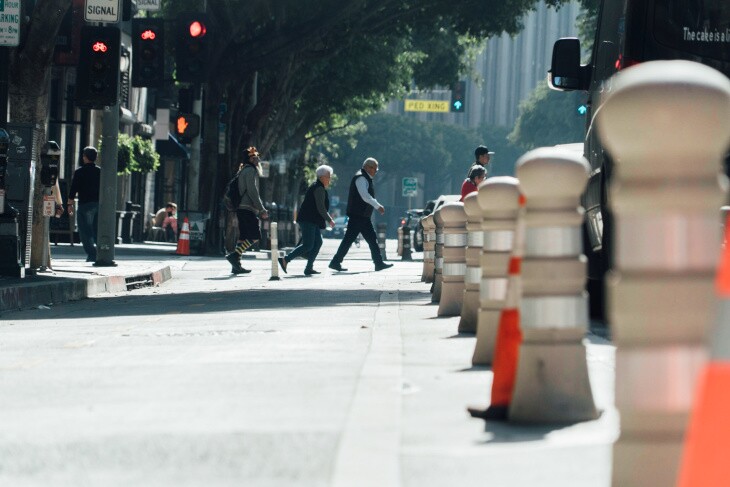What L.A.'s Budget Cuts Mean For Street Safety Projects
The following article was originally published April 21, 2020, and republished through a collaboration with KPCC and LAist.
Story by Ryan Fonseca
The office of Los Angeles Mayor Eric Garcetti released its proposed city budget for the upcoming fiscal year, which includes substantial funding cuts in many departments as L.A. leaders face reduced revenues due to the COVID-19 crisis.
I've been reporting on street safety in L.A. and wanted to know how the city's program to eliminate traffic deaths — which some city leaders have described as an epidemic — will be impacted.
That program, Vision Zero, identifies streets and intersections where pedestrians are seriously injured and killed at high rates — known as the High-Injury Network — and then makes safety improvements like high-visibility crosswalks, speed bumps and protected bike lanes. The program also includes ramped-up traffic enforcement and community outreach campaigns.
For the current fiscal year budget, Vision Zero received about $51.4 million — the most since its inception in 2015. But officials from the mayor's office say the program will be cut 5% in the next fiscal year, to $48 million, because of COVID-19.
The Los Angeles Department of Transportation manages the Vision Zero program. Spokesman Colin Sweeney told me LADOT will have more details about how the program — along with the rest of LADOT's operations — will be affected once they've had time to analyze the new budget, but said Vision Zero funding will remain largely intact.
"The small reduction to Vision Zero funding largely reflects the furloughs the mayor proposed in his state of the city," Sweeney said. "We do not anticipate these reductions to have any significant impact on Vision Zero programs, which reflected the mayor's continued commitment to street safety."

SO FAR, NOT SO GOOD
This year marks the halfway point for the program, which has a goal of eliminating all traffic deaths in the city by 2025. That's clearly not going well. An estimated 134 people were killed by drivers while walking in L.A. last year, an increase of about 52% from 2015 — the year Vision Zero was launched.
According to a growing number of traffic experts, safety advocates and even some city leaders, the reason behind the increased death toll is simple: Vision Zero is dramatically underfunded because L.A.'s leaders have not truly committed to the philosophy at the heart of the global street safety initiative.
A few budget cycles ago, LADOT General Manager Seleta Reynolds estimated Vision Zero would need $80 million for the 2017-18 fiscal year if leaders hoped to achieve Garcetti's goal of a 20% reduction in traffic deaths by the end of 2017. The program ended up with roughly a third of that.
"We approved the plan and we talked about the plan, but we have not moved forward with it... we have not been aggressive enough about enforcing it," City Councilman Mike Bonin told me earlier this year. "It's been on paper and it's gotten a little bit of money every year, but it still is not something that is sort of a living, breathing initiative in Los Angeles."
It's not just Vision Zero, though. The city's street improvements face cuts across the board, officials from the mayor's office said Monday.
In total, funding for infrastructure improvements will be reduced about 10%, from $888 million down to $795 million.
That means less money for safety improvements like sidewalk repairs, pedestrian plazas and more.
BUT AREN'T L.A. STREETS SAFER RIGHT NOW?
It may be tempting to look for a silver lining to Vision Zero's shortcomings in the age of COVID-19; yes, fatal traffic collisions are down compared with this same time last year, based on available city data. But an anomaly due to a pandemic should not be mistaken as progress — especially when coronavirus has claimed more than 600 lives and sickened thousands more in L.A. County alone.
In the short-term, it may be that with fewer cars on the road, fewer collisions are happening and fewer pedestrians are being struck and killed by drivers. But safety advocates and experts agree that a dramatic shift in how we perceive our streets and a unified, citywide effort to improve them is what will save lives in the long run.



